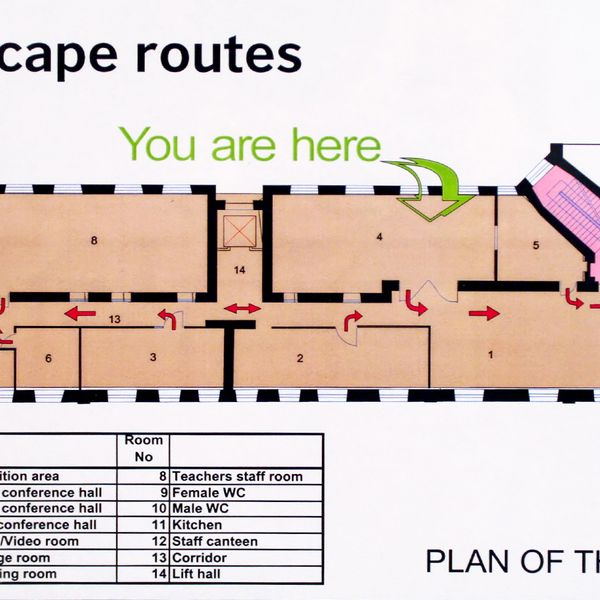Do you really need emergency maps at work? Here’s what OSHA says
If you’re in charge of workplace safety, you’ve probably asked yourself, “Do I actually need to post emergency maps to stay OSHA compliant?” It’s a fair question and the answer might surprise you.
OSHA compliance (the minimum)
In 29 CFR 1910.38 OSHA says that if your workplace falls under certain standards, you need to have an Emergency Action Plan (EAP). This plan then must cover how people will evacuate during an emergency, who’s responsible for making sure everyone gets out safely, and how you’ll account for everyone once they’re outside. However, OSHA doesn’t specifically say that you must post emergency maps.
Even though they’re not technically required, emergency maps are still “highly recommended.” OSHA even includes them in a non-mandatory appendix as a best practice. Think of them as a visual cheat sheet that helps people quickly figure out:
- where the exits are,
- which direction to go based on their location, and
- where to meet up once they are safe
In a real emergency, when stress levels are high and time is short, a clear map can make all the difference in minimizing injury and protecting lives.
Beyond just compliance
Compliance to regulatory requirements is a necessity, but is not always enough to ensure a safe workplace in all scenarios. To truly ensure safety workers, we need to dig deeper. Emergency maps enhance safety beyond compliance by:
Simplifying training: For new employees, contractors, or visitors, emergency maps provide an immediate visual reference. Instead of relying solely on verbal instructions or lengthy instructions, people can quickly see where they are and how to exit safely.
Reducing confusion: In large or complex buildings, it’s easy to get disoriented, especially in high stress situations. Clear, well-placed emergency maps help people make quick, informed decisions. They show not just exits, but can also show fire extinguisher locations, first aid kits, and safe assembly areas.
Demonstrating preparedness and proactive safety: Having visible, up-to-date emergency maps signals that your organization takes safety seriously. This can be reassuring to employees and visitors alike. It also reflects positively during inspections and audits showing that you’ve taken proactive steps to mitigate risk.
Recognizing other authorities may require it: While OSHA doesn’t require emergency maps, many local fire codes, building regulations, or industry-specific standards may. This can cause organizations to be non-compliant and face penalties without them. Additionally, insurance carriers may provide incentives to including maps in planning for emergencies.
Best practices for effective emergency maps
Overall emergency maps should be easy to read and understand, posted in visible or “conspicuous” spots like near exits, elevators, and break rooms, and updated whenever your layout or procedures change. Below is a simple checklist you can use to review your organization’s emergency maps.
Site accuracy
- Make sure all exits are easy to find on the map.
- Show where fire extinguishers, alarms, and first aid stations are.
- Point out any dangers like chemicals or machines.
- Include safe zones or meeting spots.
- Make sure the "You Are Here" marker is clear and easy to see.
Design
- Use standard symbols everyone understands.
- Include a legend to explain all symbols and icons.
- Keep the layout simple and uncrowded.
- Use high contrast between the background and text/symbols.
- Use large, easy-to-read fonts.
Accessibility
- Provide labels in different languages if needed.
- Show routes for people with disabilities.
- Consider color blindness and visual impairments in the design.
- Make the map easy to understand for all reasonable occupancies.
Placement and visibility
- Post maps at eye level.
- Place maps near exits, elevators, and busy areas.
- Make sure maps are lit up or glow in the dark in case of power outages.
- Each map should be specific to its location in the building.
Maintenance and testing
- Review and update maps at least once a year.
- Update maps after any changes to the building layout.
- Conduct drills to evaluate the effectiveness of the maps.
- Use feedback from drills to improve the maps.
Key to remember: OSHA doesn’t require posting emergency maps; however, they are strongly recommended as a best practice. Clear, visible maps help reduce confusion, speed up decision-making, and demonstrate your organization’s commitment to preparedness.

















































